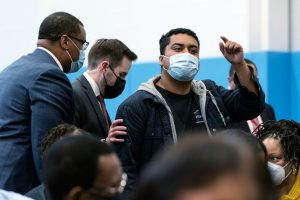COLUMBUS, Ohio — Ohio health officials urged eligible residents to get booster shots Tuesday as COVID-19 cases and hospitalizations continue to climb before the holidays.
What You Need To Know
- COVID-19 cases continue to rise in Ohio, according to state data
- Dr. Vanderhoff said he recommends booster shots for those eligible
- Despite the discouraging trends, officials said there’s reason for hope
Case rates in Ohio are at concerningly high levels, and officials fear the state of the pandemic could remain severe through the winter months.
“The problem that we’re facing right now is continued very high levels of COVID-19 activity in just about every community. In that context, you want your immunity to be at the peak of what it’s able to be,” Vanderhoff said during a news conference.
For younger adults, Vanderhoff said the primary vaccine series still offers solid protection against severe disease, but he recommends the booster dose nonetheless.
“For younger people getting the boosters, what the booster is doing is elevating their antibody levels to an even higher level to help prevent them from acquiring COVID-19, or passing it on,” he said.
Vanderhoff said the recommendation that older adults get boosters is more urgent because seniors appear to face some risk of severe illness six months after completing the primary series due to waning immunity. With virus numbers high and rising, the booster shots makes even more sense for seniors, Vanderhoff said.
In Ohio, COVID-19 cases have increased by 65% since the beginning of the month, with seven-day average cases now above 5,500. As of the latest update, 3,192 patients were hospitalized with COVID-19, which represents a 47% increase since Nov. 6. Health officials are unsure just how high this surge will go, Vanderhoff said, explaining that COVID-19 has been a very difficult virus to model.
“What we know is what we’re facing right now, and we are heading into the winter with very high levels of disease transmission, and over the last couple of weeks, a definite upturn in the number of cases and the number of hospitalizations, so essentially, we’re heading into the winter already in a surge. When this surge will peak and when it will begin to decline, we really are not able to answer that,” he said.
In northwest Ohio, where Vanderhoff said the situation is most dire, hospitalizations are at the highest levels since January.
Despite the discouraging virus trends, Vanderhoff said he continues to believe the virus is “beatable,” sharing several reasons why he is hopeful.
Counties with high vaccination rates continue to document lower case rates, which he said is evidence that the shots are making a significant difference in reducing transmission.
Looking at the northwest Ohio surge, the four counties with the highest vaccination rate have a combined case rate of 569.3 per 100,000 residents over the last two weeks, whereas the remaining 14 counties have a case rate of 918.6.
“While you can still see the cases are high in all of these counties — in fact, in all of Ohio’s counties — it’s clear that a higher vaccination rate is correlated with a lower case rate. Simply put, it’s a further demonstration of the protective impact of vaccination,” he said.
In the three weeks since vaccines were approved for children ages 5 to 11, 11.1% of newly eligible kids in Ohio have received a dose of the vaccine, he said. Vanderhoff said these kids are well on their way to having the same immunity enjoyed by most adults.
He also said he is expecting oral therapeutics for treating COVID-19 infection to be available by mid-December, which could improve patients’ outcomes. Vanderhoff said it’s important to note that the oral pills will not be widely available immediately upon authorization.
“The supply just won’t enable it to be something that is as simple as picking up at your local pharmacy,” Vanderhoff said.
Dr. Thomas Herchline, professor of medicine at Wright State University, and Wood County Health Commissioner Benjamin Robison joined Vanderhoff for the news conference.
Herchline said the new booster recommendation should not scare Ohioans that the vaccines are not keeping them protected.
“It certainly does not mean the vaccines are failing,” he said. “Now that we have more follow up — we have basically a year of follow up for people that have been getting the vaccine… we recognize that once it’s been more than six months, there’s a significant benefit to receiving a booster.”
Robison said he is concerned about a post-Thanksgiving spike, given that cases numbers have consistently risen in the aftermath of previous holidays. He said he recommends residents take a rapid test before gathering to add an additional layer of protection.
“That way, when we look back on these celebrations, we can think about the memories that were made and not so much the disease that we’re fighting on the other side of our celebrations,” he said.




